Structural and Functional Characterizations of Cancer Targeting Nanoparticles Based on Hepatitis B Virus Capsid.
Heo, Y., Jeong, H., Yoo, Y., Yun, J.H., Ryu, B., Cha, Y.J., Lee, B.R., Jeon, Y.E., Kim, J., Jeong, S., Jo, E., Woo, J.S., Lee, J., Cho, H.S., Lee, W.(2021) Int J Mol Sci 22
- PubMed: 34502049
- DOI: https://doi.org/10.3390/ijms22179140
- Primary Citation of Related Structures:
7EOY, 7EP6, 7FDJ - PubMed Abstract:
Cancer targeting nanoparticles have been extensively studied, but stable and applicable agents have yet to be developed. Here, we report stable nanoparticles based on hepatitis B core antigen (HBcAg) for cancer therapy. HBcAg monomers assemble into spherical capsids of 180 or 240 subunits. HBcAg was engineered to present an affibody for binding to human epidermal growth factor receptor 1 (EGFR) and to present histidine and tyrosine tags for binding to gold ions. The HBcAg engineered to present affibody and tags (HAF) bound specifically to EGFR and exterminated the EGFR-overexpressing adenocarcinomas under alternating magnetic field (AMF) after binding with gold ions. Using cryogenic electron microscopy (cryo-EM), we obtained the molecular structures of recombinant HAF and found that the overall structure of HAF was the same as that of HBcAg, except with the affibody on the spike. Therefore, HAF is viable for cancer therapy with the advantage of maintaining a stable capsid form. If the affibody in HAF is replaced with a specific sequence to bind to another targetable disease protein, the nanoparticles can be used for drug development over a wide spectrum.
- Structural Biochemistry & Molecular Biophysics Laboratory, Department of Biochemistry, College of Life Science and Biotechnology, Yonsei University, Seoul 03722, Korea.
Organizational Affiliation:
















